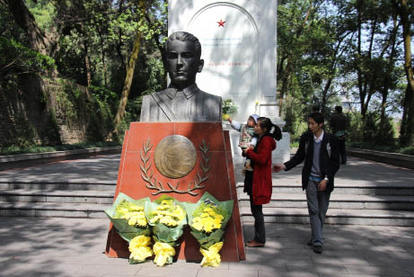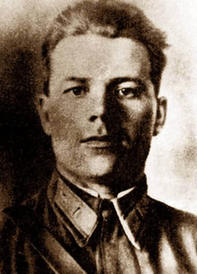Faces of the War
Grigori Akimovich Kulishenko
Building of the tomb of Grigori Akimovich Kulishenko in Xishan Park in Wanzhou, Chongqing, was completed in 1958. That year, the Red Cross Society of China, on behalf of the Chinese government, invited Kulishenko’s widow and daughter to China to attend a sacrificial ceremony at the tomb during the October 1 National Day holiday. Later, at the National Day reception in Beijing, Chinese Premier Zhou Enlai told them, “The Chinese people will always remember Grigori Kulishenko.”
|
 |
|
Chongqing citizens pay a visit to the tomb of Grigori Akimovich Kulishenko. |
From the end of 1937 to 1939, the Soviet Union sent more than 2,000 air force personnel to give battle in China, 700 of whom took part in aerial campaigns in defense of Nanjing, Wuhan and Chongqing. More than 200 of these airmen sacrificed their lives for China. Kulishenko was one of the two highest ranking Soviet air force officers.
Born in Ukraine, Kulishenko had been commander of a Soviet Union fighter squadron. In May 1939, he led a volunteer squadron of long-range bombers to help China fight Japanese invaders. They landed and were stationed at Chengdu Shuangliu Taipingsi Airport.
In addition to battle missions, these Soviet airmen were also responsible for training Chinese aviation personnel. Kulishenko personally conducted stringent flight instruction programs to perfect Chinese pilots’ flying skills. By the summer of 1939, he and his fellow Soviet Union instructors had trained more than 1,000 Chinese pilots, 80 navigators and 8,000 aviation technicians.
On October 14, 1939, Kulishenko led his squadron in a life-and-death struggle against Japanese fighter planes over Wuhan. His bomber shot down six Japanese planes. Kulinshenko’s aircraft, however, was hit and he was forced to return to the base. His plane lost balance as it flew over Wanzhou, now a district of Chongqing. To ensure the safety of people on the ground, Kulishenko executed a landing on the Yangtze River. Others of the aircrew were able to scramble out, but Kulishenko could not escape from the cabin before it flooded. His body was found 20 days later. He was buried at the foot of a hill in Wanzhou.
|
 |
|
Grigori Akimovich Kulishenko. |
Word of Kulishenko’s heroic deeds soon spread throughout the country. As the volunteers’ location in China was classified information, Kulishenko’s family in the Soviet Union did not receive the tragic news that he had been killed in action until several months later. Even then, they were not told about the manner or place of his death.
The Chinese people have never forgotten Kulishenko. Since the 1970s, the Ministry of Civil Affairs has allocated funds on four occasions specifically to renovate his tomb. It was designated in 2009 as site of a Memorial for Martyrs under National Protection. In 2013, Chinese President Xi Jinping delivered a speech at the Moscow State Institute of International Relations. He made special mention of the Chinese mother and son, Tan Zhonghui and Wei Yingxiang, who have tended Kulishenko’s tomb for more than 50 years, so attesting to the friendship between China and Russia.
“I heard Kulishenko’s story from my mother. I have told it to my son and will in turn tell it to my grandson. I think of it as a legacy,” Wei Yingxiang said. After hearing about this mother-and-son team through President Xi’s speech, Kulishenko’s grandson personally called Wei Yingxiang. “His gratitude is my best possible commendation,” Wei said.
